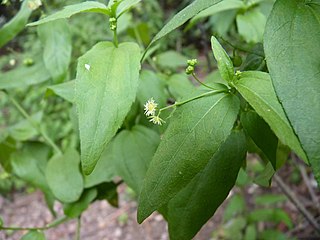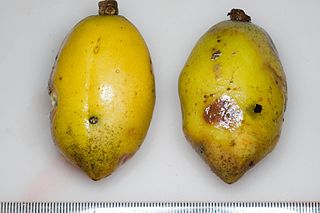
Cnidoscolus is a plant genus of the family Euphorbiaceae first described as a genus in 1827. The group is widespread across much of North and South America, including the West Indies.

Cleidion is a plant genus of the family Euphorbiaceae, first described in 1826. It is found in tropical and subtropical regions in Asia, Africa, Australia, Latin America, and various islands of the Pacific and Indian Oceans.
Bernardia is a plant genus of the family Euphorbiaceae first described for modern science as a genus in 1754. It is native to North and South America, as well as the West Indies.
Caryodendron is a plant genus of the family Euphorbiaceae first described as a genus in 1860. The genus includes C. orinocense, known as the Inchi tree or Tacay nut. It is native to Central America and South America. They are dioecious trees.
- Caryodendron amazonicumDucke - Amazonas in Brazil
- Caryodendron angustifoliumStandl. - Costa Rica, Panama, Colombia
- Caryodendron janeirenseMüll.Arg. - Rio de Janeiro
- Caryodendron orinocenseH.Karst - Colombia, Venezuela, Ecuador

Caperonia is a genus of plants of the family Euphorbiaceae first described as a genus in 1825. The genus is native to tropical and subtropical America and Africa.

Chiropetalum is a plant genus of the family Euphorbiaceae first described as a genus in 1832. It is widespread across relatively dry regions of North and South America from Texas to Uruguay.

Ditaxis is a plant genus of the family Euphorbiaceae first described as a genus in 1824. Its name comes from Greek dis ("two") and taxis ("rank"), referring to the stamens which are in two whorls. The genus is widespread across much of the Western Hemisphere from the southern United States to Uruguay.
Romanoa tamnoides is a species of plant of the family Euphorbiaceae. It is the sole species in the monotypic genus Romanoa, first described in 1824. It is native to Brazil and Paraguay.
Acidoton is a genus of plant of the family Euphorbiaceae first described as a genus in 1788. It is native to the Greater Antilles, Central America, and tropical South America.

Glycydendron is a genus of plants, under the family Euphorbiaceae first described as a genus in 1922. It is native to South America.
- Glycydendron amazonicumDucke - French Guinea, Suriname, Guyana, Ecuador, Peru, Bolivia, northwestern Brazil, possibly Colombia
- Glycydendron espiritosantenseKuhlm, - State of Espirito Santo in Brazil

Dalechampia is a genus of plant of the family Euphorbiaceae and of the monogeneric subtribe Dalechampiinae. It is widespread across lowland tropical areas primarily in the Americas with smaller numbers of species in Africa, Madagascar, and southern Asia. Additional new species are still being described and several are very rare and at risk of extinction.
Micrandropsis is a plant genus of the family Euphorbiaceae first described as a genus in 1973. It contains only one known species, Micrandropsis scleroxylon, endemic to the State of Amazonas in northwestern Brazil.
Actinostemon is a plant genus of the family Euphorbiaceae first described as a genus in 1841. It is native to South America, Central America, and the West Indies.
Dendrothrix is a plant genus of the family Euphorbiaceae first described as a genus in 1996. It is native to southern Venezuela and northwestern Brazil.
- Dendrothrix multiglandulosaEsser - Amazonas State in Venezuela
- Dendrothrix wurdackiiEsser - Amazonas State in Brazil
- Dendrothrix yutajensis(Jabl.) Esser - Amazonas State in Brazil; Amazonas & Bolívar States in Venezuela

Gymnanthes is a genus of flowering plants in the spurge family, Euphorbiaceae, first described as a genus in 1788. It is found primarily in the warmer parts of the Western Hemisphere, but with some species in central Africa and southwestern Southeast Asia.

Mabea is a plant genus of the family Euphorbiaceae first described in 1775. It is native to Central and South America as well as Mexico and Trinidad.

Maprounea is a plant genus of the family Euphorbiaceae first named as a genus in 1775. It is native to tropical Africa, Trinidad, and tropical Central and South America.
- Maprounea africana - W + C + S Africa, from Benin to Zimbabwe
- Maprounea amazonica - Colombia, Venezuela, N Brazil
- Maprounea brasiliensis - Brazil, Paraguay, Bolivia
- Maprounea guianensis - Trinidad, Panama, Colombia, Venezuela, French Guiana, Suriname, Guyana, Brazil, Peru, Ecuador, Bolivia, Paraguay
- Maprounea membranacea - Nigeria, Cameroon, Gabon, Equatorial Guinea, Cabinda, Central African Republic, Congo, Zaire
Discocarpus is a genus of the plant family Phyllanthaceae first described as a genus in 1841. It is native to northern South America. It is dioecious, with male and female flowers on separate plants.
- Discocarpus essequeboensisKlotzsch - Brazil, Venezuela (Amazonas), Guyana, Suriname, French Guiana
- Discocarpus gentryiS.M.Hayden - S Venezuela (Amazonas), Peru (Loreto), N Brazil
- Discocarpus pedicellatusFiaschi & Cordeiro - State of Bahia in Brazil
- Discocarpus spruceanusMüll.Arg. - Venezuela (Amazonas), Brazil, Suriname (Sipaliwini), Bolivia

Campomanesia is a genus in the family Myrtaceae described as a genus in 1794. It is native to South America and Trinidad.

Pausandra is a plant genus of the family Euphorbiaceae first described in 1870. It is native to Central America and South America.
- Pausandra fordiiSecco - Amapá, French Guiana
- Pausandra hirsutaLanj. - Peru, Brazil, Bolivia (Pando), Colombia (Amazonas)
- Pausandra macropetalaDucke - Brazil, Peru (Loreto), Venezuela (Amazonas)
- Pausandra macrostachyaDucke - Pará
- Pausandra martiniBaill. - French Guiana, Suriname, Guyana, Colombia, Venezuela, Peru, Brazil
- Pausandra megalophyllaMüll.Arg. - Rio de Janeiro
- Pausandra morisiana(Casar.) Radlk. - Brazil
- Pausandra trianae(Müll.Arg.) Baill. - widespread from Honduras to Bolivia












